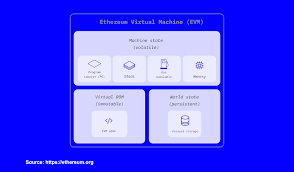Understanding the Ethereum Virtual Machine (EVM)
 Jonathan Destiny
Jonathan Destiny
Imagine a computer that isn’t tied to any single location but exists across thousands of devices worldwide. This computer, while invisible, executes programs and ensures the integrity of billions of dollars in digital assets. This is the Ethereum Virtual Machine (EVM)—the beating heart of the Ethereum blockchain.
If you’re new to blockchain or have heard of Ethereum but aren’t sure how it works, this article is for you. Together, we’ll break down what the EVM is, how it functions, and why it’s a game-changer for decentralized technology.
What is the Ethereum Virtual Machine (EVM)?
The Ethereum Virtual Machine (EVM) is like a global, decentralized supercomputer. It is the system responsible for running all the programs (called smart contracts) on the Ethereum blockchain. Think of the EVM as a middleman between developers and the blockchain: developers write programs, and the EVM ensures they run exactly as intended.
A Personal Take: Why the EVM Feels Revolutionary
When I first learned about the EVM, the idea of a decentralized "computer" felt almost magical. Unlike traditional systems where one server or company controls everything, the EVM spreads its responsibilities across thousands of nodes, ensuring fairness, transparency, and security. For me, this decentralization was a lightbulb moment—it’s what makes blockchain so powerful.
Key Features of the EVM
Global Consistency: No matter where it’s executed, the EVM ensures that the same inputs will always produce the same outputs.
Turing-Completeness: The EVM can execute any computation, as long as enough resources (called gas) are available.
Gas Fees: Every computation in the EVM costs gas, a measure of computational effort. This prevents the network from being overwhelmed by endless calculations.
For an introductory explanation, this YouTube video on the EVM is a great starting point.
How Does the EVM Work?

The EVM works by executing smart contracts, which are self-executing programs stored on the blockchain. Here’s how it works step by step:
Smart Contract Compilation: Developers write smart contracts in high-level programming languages like Solidity. These are compiled into a low-level language called bytecode, which the EVM can understand.
Transaction Processing: When a user interacts with a smart contract, the EVM processes it like this:
Fetch Bytecode: The EVM retrieves the bytecode of the smart contract.
Execute Bytecode: The EVM runs the instructions in a stack-based architecture.
Gas Calculation: Each operation consumes gas, which is deducted from the user’s balance.
Here’s a visual representation:
Security and Sandboxing: The EVM isolates smart contracts during execution. This means even if one smart contract has malicious code, it cannot affect others or the network. This sandboxing model ensures the safety of Ethereum users.
Why is the EVM Important?
The EVM is foundational to Ethereum for several reasons:
Powering Decentralized Applications (dApps):
Without the EVM, Ethereum wouldn’t be able to run dApps, which are applications that operate without centralized control. From DeFi platforms to NFT marketplaces, the EVM makes all these possible.
Interoperability:
Many other blockchains, such as Finance Smart Chain and Avalanche, are EVM-compatible, meaning they can run Ethereum-based applications without modification. This expands the reach of Ethereum developers, enabling seamless cross-chain deployments.
For example, solutions like Metis, a Layer 2 scaling platform, are fully EVM-compatible. Learn more about Metis here.
Merkle Patricia Trees in the EVM
The EVM uses a special data structure called Merkle Patricia Trees to organize and secure data. They are crucial for ensuring the integrity and efficiency of Ethereum’s state.
What is a Merkle Patricia Tree
A Merkle Patricia Tree is a hybrid data structure that combines the features of Merkle Trees and Patricia Tries. Ethereum uses these trees to:
Track account balances and contract storage (state trie).
Record transactions (transaction trie).
Log transaction outcomes (receipt trie).
How Do They Work?
Merkle Patricia Trees store data as key-value pairs. Each node in the tree is hashed, creating a unique identifier. This makes it easy to detect tampering with even a single piece of data.
For a more technical dive, explore this guide on Merkle Patricia Trees.
My Perspective on Merkle Patricia Trees
When I first encountered Merkle Patricia Trees, I struggled to understand their complexity. But breaking them down helped: they’re essentially a way to organize data efficiently while maintaining security. This structure ensures Ethereum can handle thousands of transactions without sacrificing performance. It's like having a super-organized filing system that updates itself automatically when something changes.
Conclusion
The Ethereum Virtual Machine is more than just a component of Ethereum; it’s the core of decentralized innovation. By enabling the execution of smart contracts and maintaining security across a decentralized network, the EVM has paved the way for blockchain technology to reach new heights. The EVM may seem complex at first, but once you understand its principles, it becomes clear why it’s such a groundbreaking technology.
Subscribe to my newsletter
Read articles from Jonathan Destiny directly inside your inbox. Subscribe to the newsletter, and don't miss out.
Written by
